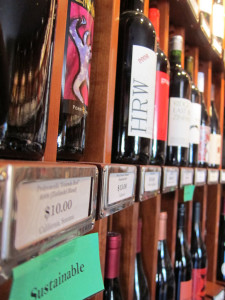As most of you are aware, there is a growing movement toward more sustainable practices in many industries; the wine industry included. In a world of uncertainty linked to a changing climate, many growers and producers are trying to adopt more

Photo courtesy US Dept of Ag
sustainable practices to help offset the large carbon footprints produced by industry all over the world.
In regards to the consumer, research has shown that while they appreciate the effort of the food and wine industries in becoming more sustainable, they don’t always know or completely understand what exactly that means. While some people might believe the sustainable label refers to environmental practices, others might look at it from a human health standpoint. Both may be right, but simply seeing a sustainable label on a bottle leaves the reasoning up for interpretation. As a result of this confusion, it is not well understood just how much people are willing to pay for wines that are labelled as being produced in a sustainable manner.
The International Organization of Vine and Wine (OIV) defines sustainable winegrowing and winemaking as:
“a global strategy on the scale of grape production and processing systems, incorporating at the same time the economic sustainability of structures and territories, producing quality products, considering requirements of precision in sustainable viticulture, risks to the environment, products safety and consumer health and valuing of heritage, historical, cultural, ecological and aesthetic aspects”.
That’s not exactly a short and sweet definition, and with multiple types of certifications available for various sustainable production practices, it can be understandably confusing for a consumer who is not well informed about sustainable wines.
In regards to purchase behavior, studies have shown that there are several extrinsic and intrinsic characteristics that consumers evaluate prior to purchasing a bottle of wine. Often times, the consumer is taking a bit of a risk on purchasing a particular bottle, since there often isn’t a way for them to taste the wine prior to purchase. In order to mitigate this risk, the consumer

Photo courtesy Flickr user Gozamos
relies on what is written on the front and back labels of the wine to determine whether or not they will purchase the bottle.
Studies on purchase behavior for sustainable wines have shown mixed results. First, a 2014 study found that consumer interest in a given wine increased when it was labelled as “sustainable” or “natural”. On the other hand, other studies have shown a bit of skepticism on the part of the consumer, with the consumer doubting whether or not the claims of sustainability are real or if they are just a marketing ploy. Additionally, since many consumers associate with wine already being a natural and/or sustainable product, seeing a sustainable certification on the bottle may not influence purchase behavior for those types of wines. Finally, another study found an increased willingness to pay for some consumers in regards to the purchase price for sustainable wines.
A new study, published in the British Food Journal, aimed to add to the understanding of sustainability claims on wine labels, and how these claims affect purchase behavior and willingness to pay in Italian wine drinkers (which is a group for which this has not yet been studied in great detail).
Brief Methods
An online questionnaire was utilized for this study, including questions on wine consumption and purchase behaviors, attitudes toward sustainable certifications and wines labelled as sustainable, willingness to pay for sustainable wines, and demographic and socio-economic characteristics. To answer these questions, participants were asked to imagine they were in the shop to purchase a bottle of wine to drink at home.
Selected Results
- A total of 495 Italian adults participated in the online surveys.
- 62.8% were male (37.2% female), average age was 39, and 80% of the participants were under the age of 50.
- 62.8% had a university degree (either undergraduate or higher).
- Most participants were employed.
- 61.8% were from northern Italy, 16.6% from central Italy, and 21.6% from southern Italy.
- 65% reported drinking wine on a weekly basis.
- 35.5% preferred to purchase wine at a supermarket, 34.3% directly from the producer, and 21.8% from wine shops.
- Analysis of the surveys yielded 4 distinct groups of consumers.
- Group 1; “Well-disposed”:
- Had the most participants (257)
- 43% were female
- Ages ranged between 31 and 40
- 38% preferred to purchase wine from the supermarket
- Believe very strongly in sustainable certification
- Had a positive attitude toward sustainable wine
- Willing to pay €2.01-3.00 more per bottle for a sustainable wine
- Group 2; “Not Interested”:
- Youngest group (most participants were between 18 and 30)
- 41% preferred to purchase wine from the supermarket
- Had negative believes toward environmental protection
- Not interested in environmental programs
- Willing to pay €1.01-2.00 more per bottle for a sustainable wine
- Group 3: “Skeptical”:
- Had the next most number of participants (107)
- 33% were from southern Italy (total average of all participants was 22%)
- Ages ranged between 51 and 60
- 46% preferred to purchase wine directly from the winery
- Had very positive feelings about sustainable wine
- Had negative beliefs about sustainable certification
- Willing to pay €3.01-5.00+ more per bottle for a sustainable wine
- Group 4: “Adverse”:
- 80% were male
- Ages mostly over 60
- 28% preferred to purchase wine from wine shops (compared to 21% average)
- Uninterested in sustainable wine
- Willing to pay zero to less than €1.00 more per bottle for a sustainable wine
- Group 1; “Well-disposed”:
- Sensory characteristics and previous tasting experience were found to be the main drivers of purchase decisions.
- The occasion and the price were the next most important factors in purchase decisions.
- Environmental, organic, and ethical certifications were the least important in consumer purchase decisions for wine.
- Participants with a positive attitude toward environmental protection were willing to pay much more for a bottle of sustainable wine than participants with a negative attitude.
- Sustainable certification did not influence willingness to pay as much as general concerns about environmental protection did.
- For participants who usually buy very inexpensive wines, they had a zero to very low willingness to pay extra for the same bottle with a sustainable label on it.
- For participants who usually purchase wines between €3 and €9, 40% of them said they would be willing to pay €1-2 more for the same bottle with a sustainable label on it.
- For participants who usually purchase wines over €15, 21% of them said they would be willing to pay at least €5 more for the same bottle with a sustainable label on it.
Conclusions
The results of this study provide some information regarding the preferences of and willingness to pay for sustainable wines in the Italian population. However, according to the demographics results, the sample population did not represent the general Italian population. The participants in this study tended to be younger, more educated, and more from the northern part of Italy than the general population. This means that any conclusions made based on these results should not be over generalized.
It was interesting to see how the different groups of participants emerged, particularly in regards to their attitudes and beliefs toward sustainable wine and environmental issues in general and how that relates to their willingness to pay for sustainable wines. Basically, the results found four distinct groups of people: those with positive beliefs/attitudes toward sustainability, those with positive attitudes toward environmental protection but negative feelings on sustainable certifications, those with a negative attitude toward environmental protection, and those with no interest whatsoever in sustainability certifications or sustainable wines.
Though these results may not be generalizable to the entire Italian wine drinking population, nor can we assume the results would be the same in other markets (like the US), at the very least it provides some information for marketers attempting to
target specific types of people. Not everyone feels the same way about environmental issues or sustainable wine, so knowing how these attitudes are separated into more focused groups might help marketers develop better advertising and educational programs in order to ultimately increase sales of their sustainable wines.One thing I found interesting was that in this study population, positive attitudes toward environmental issues and protection was more important than having a sustainable certification on the label. As long as the winery cares about the environment in some way, shape, or form, it doesn’t seem to matter what sort of certification is mentioned on the label.
Overall, this study may provide information for marketers attempting to focus their advertising and education on a smaller niche of people, though because the sample was not representative of the general Italian population, more work should be done in order to confirm or refute the findings found here. It would also be interesting to see how these results hold up (or don’t) against other cultures (like the US, for example).
What do you all think of this small study? Feel free to share your comments/questions/etc with us!
Source:

![Photo By Riksanteri (Own work) [Public domain], via Wikimedia Commons](http://www.academicwino.com/wp-content/uploads/2016/04/EKO_symbol_RGB-the-academic-wino.jpg)
1 comment for “Wine Economics 101: Willingness to Pay for Sustainable Wines by Italian Adults”